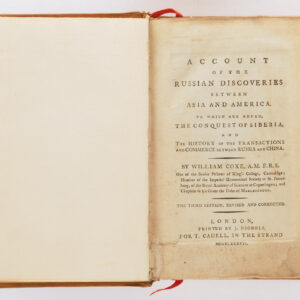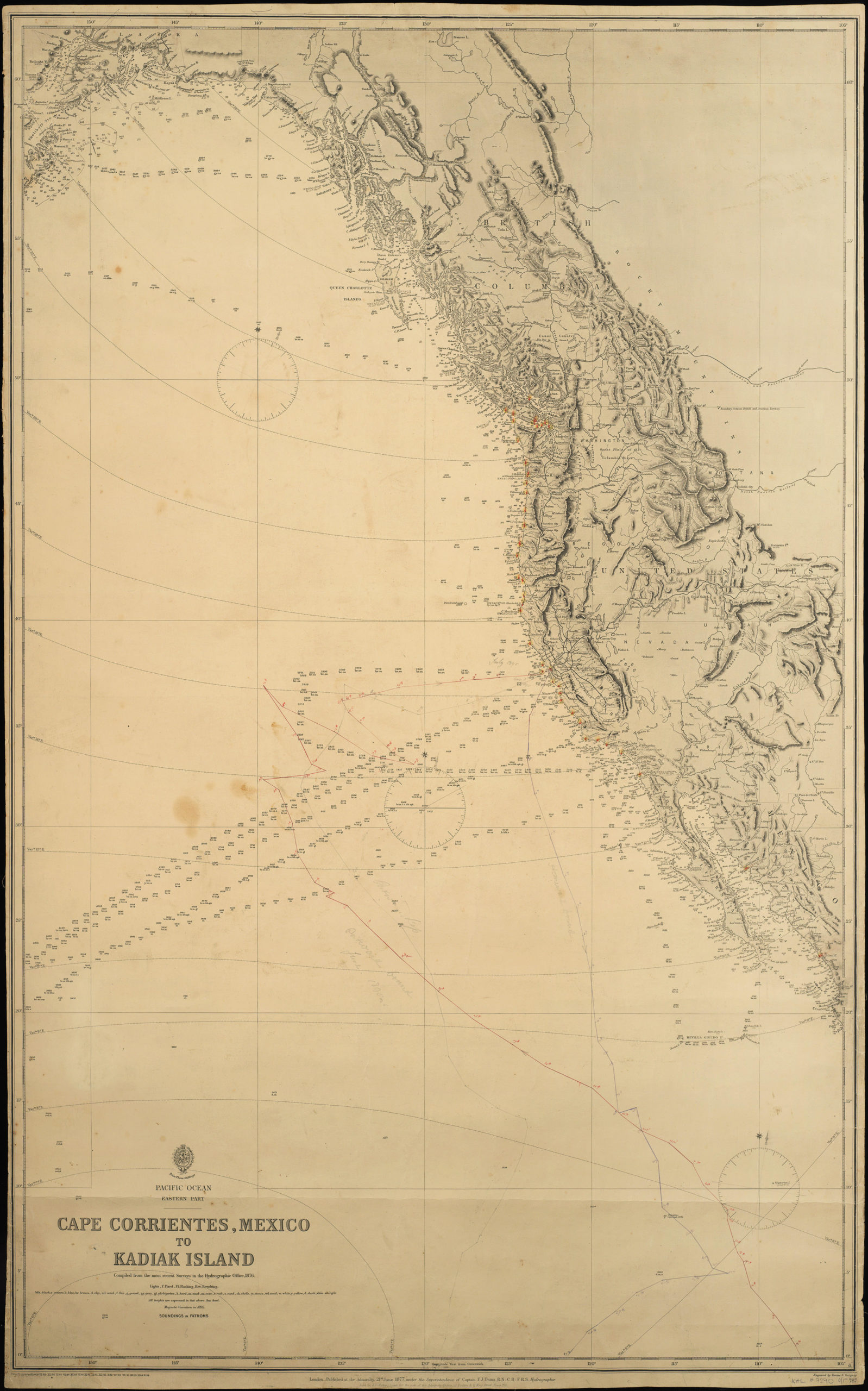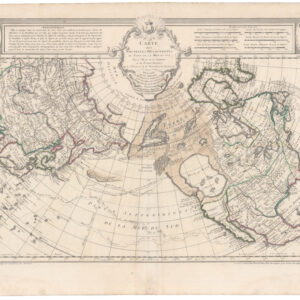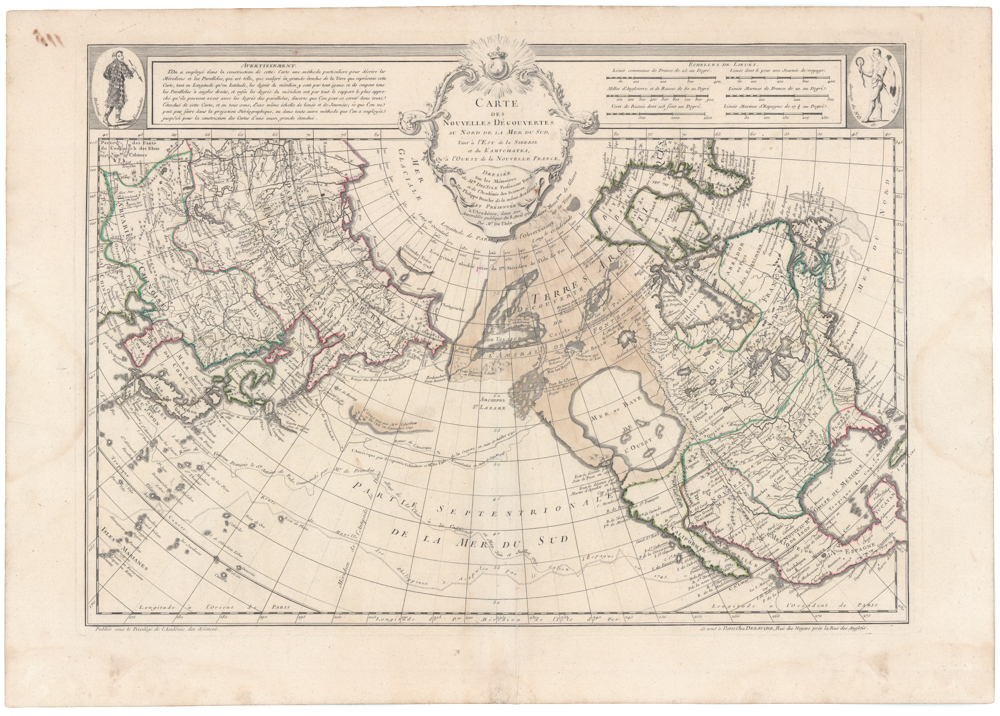Documenting Russian settlement in North America – rare map of south Kodiak Island with inset view of Pavlov’s Harbor.
Plate XVI from Atlas severnoi chasti Vostochnago Okeana [Atlas of the Northern Part of the Pacific Ocean]
Out of stock
Description
The Russian empire is often ignored as one of the great colonial empires, for a variety of possible reasons. One might be that its colonies were mostly on the same landmass as and contiguous with its homeland—a factor which is true but does overlook the vast Russian claims to North America that were ceded to the United States of America in the Alaska Sale.
The Russian empire laid claim to the North American coast from Alaska as far south as Sonoma County, California—where they founded Fort Ross in the early nineteenth century—to seize control of the land just north of the Spanish holdings, which extended to the San Francisco Bay.
The Russian imperial project on the American continent can be said to have started with Peter the Great, who, a few months before his death in February, 1725, commissioned Vitus Bering to explore the eastern-most extent of the Russian empire, and, if possible, discover whether a chain of mountains connected the two lands, as many at the time believed. Peter probably was interested to know how far he could extend his dominion to the east. (One reason the Russian empire is not recognized alongside the other empires may be its notorious inefficiency, or perhaps its notorious secrecy: a Russian expedition led by Semyon Ivanovich Dezhnev had sailed and charted the Asian coast from the Kolyma River on the Arctic Ocean, through the Bering Strait to the Anadyr River, on Asia’s east coast, north of the Kamchatka Peninsula. This expedition, however, appears unknown to Peter the Great or Bering.)
Bering’s first mission failed to sight America, and in 1732, while Bering traveled to St. Petersburg, a commander named Mikhail Gvozdev with some of the officers from Bering’s first Kamchatka expedition sighted the Alaskan coast, initiating Russia’s imperial expansion into North America.
Driven by the riches of the fur trade, especially the fur of the northern sea otter—the thickest fur of any animal—the Russian presence in North America began to expand in the late 18th century, reaching its southernmost extent with the settlement of Fort Ross at the beginning of the nineteenth century.
When the U.S. bought Russian possessions in North America in the 1867 Alaska Purchase, it added 586,000 square miles (about 1.5 million square km), about 15% of the current total U.S. land area. Russian profits from the territories had declined with the collapse of the sea otter population, and after their defeat at British hands in the Crimean War (1856), Russia began looking for a way to support its depleted treasury, and disposing of the North American territories was seen as removing the pressures from both the British and the United States, who both aspired to control those areas.
The Sarychev map, drawn at the height of Russian power in the Americas, shows the original Russian-American capital on Kodiak Island, where the first Russian settlements of America had been established in the late 18th century, and which was, at the time of the map’s creation, still the maritime center of Russian commercial operations in the Americas.
The map depicts the southeastern coast of Kodiak island, from the original Russian settlement at Three Saints Bay, which is now Old Harbor, in the west, to the second Russian settlement, at Pavlov Bay which had become the center of trade, near present-day Kodiak. The map includes a detailed inset of the second Russian settlement site at Pavlov Harbor, the site of present-day Kodiak, near the east end of the island.
The original settlement at Three Saints Bay was situated near the middle of Kodiak Island’s southeast coast (the main axis of the island runs northeast-southwest). The site had a good harbor, but little land on which to build—the hills run too steeply to the sea. The southern coast also had little timber.
The second site, Pavlosk, at Pavlov’s Harbor (Paul’s Harbor), which is the site of present-day Kodiak, was considered a more defensible spot (important because of the hostile relations between the Russians and native peoples), and had good access to timber. From its founding in 1792 to 1804, Pavlovsk was the capital of Russian America, at which point the capital was moved to Novoarkhangelsk (New Archangel, on the site of present-day Sitka, Alaska). Through the heyday of the Russian fur trade, the port at Pavlov’s Harbor was one of the most important sites for the fur trade. Russian imperial strategy did not, however, focus on settlement, but rather relied on native populations to provide furs (often at threat of force), and as a result, none of the cities of Russian America grew to be large settlements (not even those climactically hospitable areas, like Fort Ross on the California coast). In the first decade of the 19th century, a warehouse was built in Pavlovsk for the fur trade, and that building still stands, currently operated as the Baranov Museum (named for Alexander Andreyevich Baranov, who would soon become governor of Russian America).
The rarity of the map is, perhaps, an artifact of Russian attempts to suppress detailed knowledge of their holdings for fear of aiding colonial or commercial competitors.
Cartographer(s):
Condition Description
Backed with translucent paper; marginal chips, one of these large but not touching the engraving; tears, including some reaching into the image, but stabilized by the backing.
References
RBH and ABPC record no copy of the atlas having been offered at auction. WorldCat locates just one complete copy, at the University of Alaska Fairbanks, and one incomplete copy in the U.S. Geological Survey Library.
Baker, National Geographical Magazine, vol 13, no. 3, 1902, pp 86-92. Falk 1826 -26, 27 (R at front).





